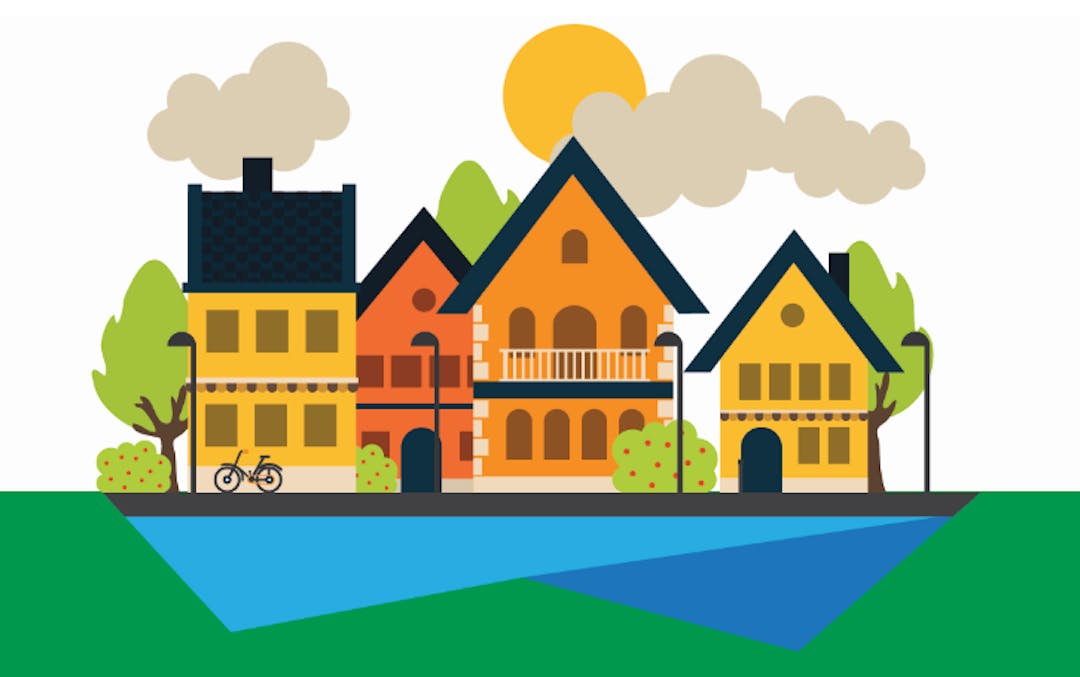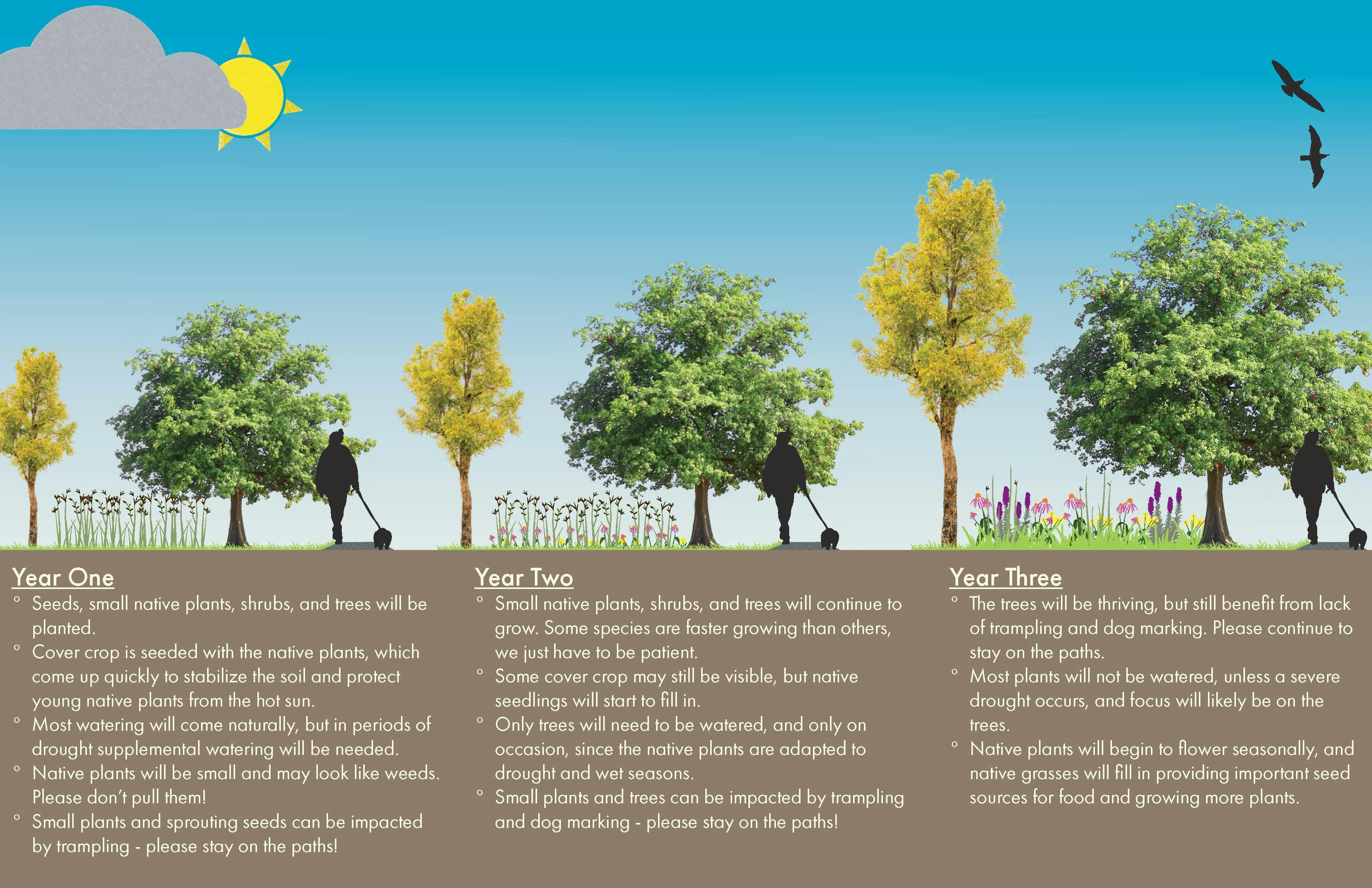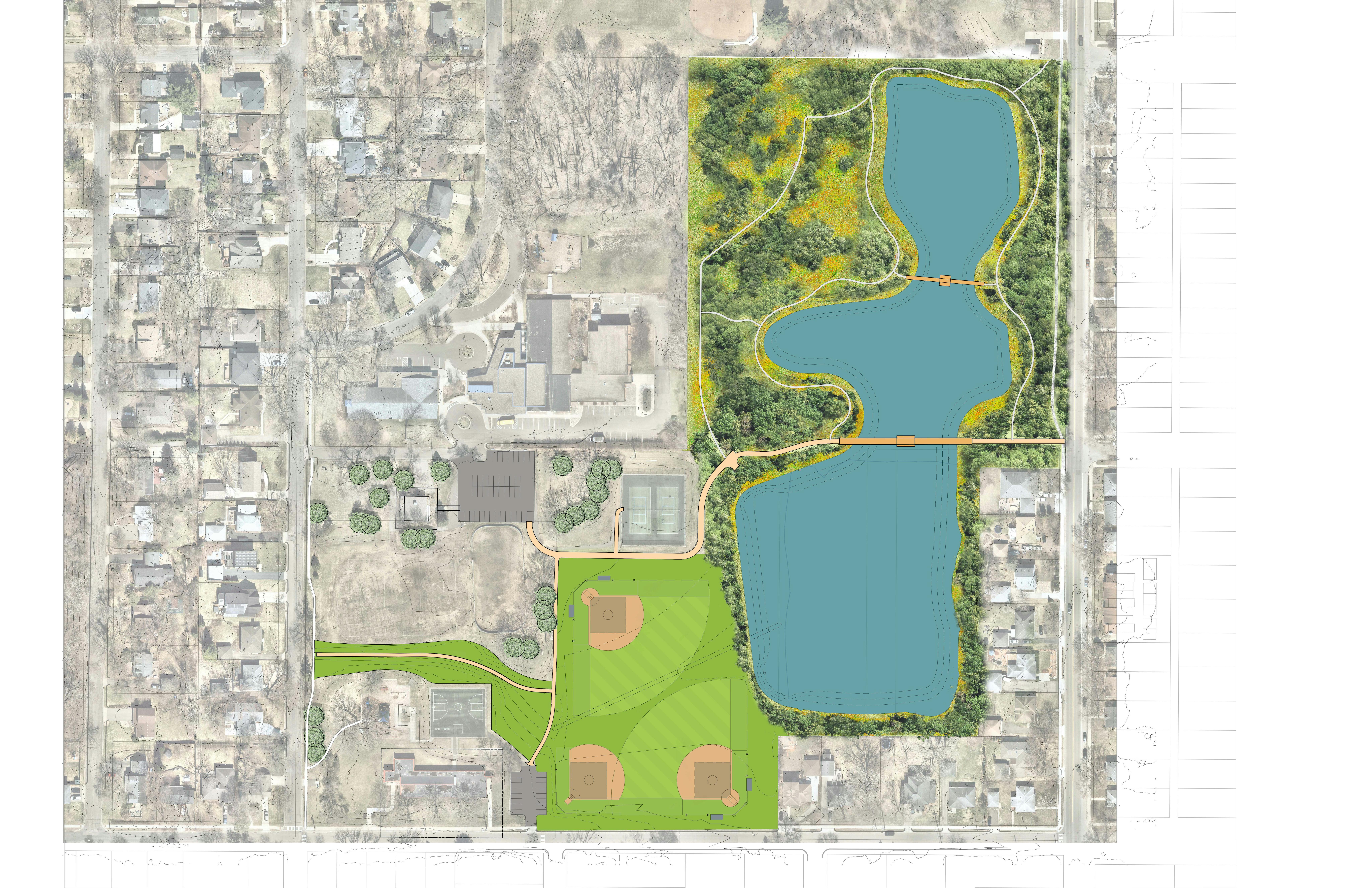Morningside Flood Infrastructure Project
This project has been completed and this project page will no longer be updated. Please contact staff with any questions or comments. Thank you.

The Morningside Neighborhood has several low and landlocked areas prone to flooding. Climate change has already increased the risk of flooding and will continue to do so. This project helps the community be more resilient to flooding. Project benefits are balanced across the neighborhood and there is no increase in risk to any property.
Ponds, pipes and a surface swale will be used to safely move and store floodwaters. An expanded pipe and swale will provide overflow from the Lynn/Kipling inundation area and the Grimes Avenue low point, and an expanded and reconfigured pipe network and minor grade changes will move water away from homes. Weber Pond and the Lynn/Kipling Pond will be expanded and lowered. About six acres of trees will be removed in Weber Woods to accommodate the larger ponds.
The flood infrastructure project also includes:
- Natural resources restoration in upland areas.
- Nature trails and bridge crossings at two locations at Weber Park.
- Improved pedestrian access to the park with some ADA-compliant paths in Weber Park.
- Rebuilt sports fields in impacted areas with new turf and irrigation systems.
The flood infrastructure project coincides with planned roadway reconstruction in the neighborhood in 2022 and 2023.
The Morningside Neighborhood has several low and landlocked areas prone to flooding. Climate change has already increased the risk of flooding and will continue to do so. This project helps the community be more resilient to flooding. Project benefits are balanced across the neighborhood and there is no increase in risk to any property.
Ponds, pipes and a surface swale will be used to safely move and store floodwaters. An expanded pipe and swale will provide overflow from the Lynn/Kipling inundation area and the Grimes Avenue low point, and an expanded and reconfigured pipe network and minor grade changes will move water away from homes. Weber Pond and the Lynn/Kipling Pond will be expanded and lowered. About six acres of trees will be removed in Weber Woods to accommodate the larger ponds.
The flood infrastructure project also includes:
- Natural resources restoration in upland areas.
- Nature trails and bridge crossings at two locations at Weber Park.
- Improved pedestrian access to the park with some ADA-compliant paths in Weber Park.
- Rebuilt sports fields in impacted areas with new turf and irrigation systems.
The flood infrastructure project coincides with planned roadway reconstruction in the neighborhood in 2022 and 2023.
This project has been completed and this project page will no longer be updated. Please contact staff with any questions or comments. Thank you.
-
Topographic Map shows high and low areas
Share Topographic Map shows high and low areas on Facebook Share Topographic Map shows high and low areas on Twitter Share Topographic Map shows high and low areas on Linkedin Email Topographic Map shows high and low areas linkCheck out this topographic relief map to see the highest and lowest areas in the neighborhood.
Weber Park is the low area in the neighborhood. Water from the north and south portions of the neighborhood generally flow toward 41st corridor and 42nd street. Upon reaching the 41st corridor and 42nd street, water moves east to Weber Pond. Water leaves Weber Pond through a storm sewer pipe to the north toward Bde Maka Ska in Minneapolis.
-
Engineering and Design in Full Swing
Share Engineering and Design in Full Swing on Facebook Share Engineering and Design in Full Swing on Twitter Share Engineering and Design in Full Swing on Linkedin Email Engineering and Design in Full Swing linkThis is what we're up to;
- We've had a chance to review the comments and questions we heard from the public and the City Council and we are using that to go further on engineering and design options that seem to have support.
- We're sketching out what a re-imagined Weber Park and Weber Woods could look like with help from the Parks Department and getting more refined estimates of cost and flood benefit.
- We're meeting with stakeholders to test our ideas.
-
Reminder - Take the survey
Share Reminder - Take the survey on Facebook Share Reminder - Take the survey on Twitter Share Reminder - Take the survey on Linkedin Email Reminder - Take the survey linkDo you have 5 minutes to tell us what you think about the initial concepts shared at the September 3rd virtual meeting?
-
Virtual Meeting #2 - Thank you for participating!
Share Virtual Meeting #2 - Thank you for participating! on Facebook Share Virtual Meeting #2 - Thank you for participating! on Twitter Share Virtual Meeting #2 - Thank you for participating! on Linkedin Email Virtual Meeting #2 - Thank you for participating! linkThank you for hanging with us for virtual meeting #2! Check out the discussion here. We'll be responding to your questions and comments over the next few days.
Share your reaction with us! Take the survey, submit an idea, ask a question, and/or tell a story.
We'll use what we've learned from you during this check-in to further refine options. We'll be back this winter to share our work and get your reaction. In the meantime, tell us what you think and check back here for updates on our progress.
-
Reminder - Join us on September 3rd for Virtual Meeting #2
Share Reminder - Join us on September 3rd for Virtual Meeting #2 on Facebook Share Reminder - Join us on September 3rd for Virtual Meeting #2 on Twitter Share Reminder - Join us on September 3rd for Virtual Meeting #2 on Linkedin Email Reminder - Join us on September 3rd for Virtual Meeting #2 linkThe second virtual public meeting will be held from 5-6:30 p.m. on September 3rd. Access the video under the 'Virtual Meetings' tab.
We used your input from the first meeting to help develop initial concepts for reducing flood risk in Morningside. Thank you for your input! The initial concepts and their pros and cons will be presented at the virtual meeting on September 3rd. Join us to hear about the concepts, ask questions, and share your opinions.
-
Flood Risk in the Morningside Neighborhood
Share Flood Risk in the Morningside Neighborhood on Facebook Share Flood Risk in the Morningside Neighborhood on Twitter Share Flood Risk in the Morningside Neighborhood on Linkedin Email Flood Risk in the Morningside Neighborhood link -
Is there something we need to see?
Share Is there something we need to see? on Facebook Share Is there something we need to see? on Twitter Share Is there something we need to see? on Linkedin Email Is there something we need to see? linkWe make house calls! Outdoor, masked, and physically-distanced.
Is there something we need to see to better understand an issue? Could you use some advice on a flooding or drainage issue? Send us an email or give us a call to arrange a meeting.
-
Videos simulate flooding during storm events
Share Videos simulate flooding during storm events on Facebook Share Videos simulate flooding during storm events on Twitter Share Videos simulate flooding during storm events on Linkedin Email Videos simulate flooding during storm events linkWe’ve been using a process called two-dimensional (or 2D) modeling to simulate storm events and help us get a better idea of what happens during a flood.
With this tool, we can better visualize the path flood water takes through streets, parks, and properties. Additionally, we can see the timing of those flow paths. We’re seeing streets flowing with water, streets full of water overflowing the curbs, and low areas filling with water and spilling over to other low areas.
View the video playlist on the Edina TV YouTube page.
10yr refers to a storm that has a 10% chance of occurring each year. This would be 4.3 inches in 24 hours.
50yr refers to a storm that has a 2% chance of occurring each year. This would be 6.4 inches in 24 hours.
100yr refers to a storm that has a 1% chance of occurring each year. This would be 7.5 inches in 24 hours.
-
View flood data in Google Earth
Share View flood data in Google Earth on Facebook Share View flood data in Google Earth on Twitter Share View flood data in Google Earth on Linkedin Email View flood data in Google Earth linkThis tool allows you to visualize flood data in a new way. You can zoom in and out, pan around the neighborhood, and even get a ground-level view. Click the blue flood layers to see how deep the water would be in a 1% annual-chance-flood (7.5 inches in 24 hours).
Here's how to start exploring;
- Download Google Earth on your desktop computer for free, www.google.com/earth/versions/.
- Download the Morningside Neighborhood flood data from the Water Resources Library.
- Double click to open the .kmz file and it should open in Google Earth.
-
Virtual Meeting #2 - September 3rd
Share Virtual Meeting #2 - September 3rd on Facebook Share Virtual Meeting #2 - September 3rd on Twitter Share Virtual Meeting #2 - September 3rd on Linkedin Email Virtual Meeting #2 - September 3rd linkThe City will host a second virtual public meeting with residents from 5-6:30 p.m. on September 3rd.
We used your input from the first meeting to help develop initial concepts for reducing flood risk in Morningside. Thank you for your input! The initial concepts and their pros and cons will be presented at the virtual meeting on September 3rd. Join us to hear about the concepts, ask questions, and share your opinions.
Who's Listening
-
Phone 952-903-5713 Email RBintner@EdinaMN.gov -
Phone 952-826-0445 Email JWilson@EdinaMN.gov -
Phone 952-826-0317 Email TSwenson@EdinaMN.gov
Key Dates
-
July 11 2024
-
October 19 2021
-
September 21 2021
Photos
Lifecycle
-
Share Information
Morningside Flood Infrastructure Project has finished this stageSummer 2020
Information about flood risk, Edina's Flood Risk Reduction Strategy, and actions people can take to reduce their own flood risk will be shared.
-
Present Initial Concepts
Morningside Flood Infrastructure Project has finished this stageFall 2020
Initial concepts will be presented for feedback.
-
Present Refined Concepts
Morningside Flood Infrastructure Project has finished this stageWinter 2020
Refined concepts based on feedback will be presented.
-
Make a Decision
Morningside Flood Infrastructure Project has finished this stageSpring 2021
Staff will make a recommendation and City Council will make a decision.
-
Close the Loop - Concept Design Phase
Morningside Flood Infrastructure Project has finished this stageSpring 2021
The decision will be communicated to the public and archived on the Better Together Edina project page.
-
Added: Detailed Engineering and Landscape Design Begins
Morningside Flood Infrastructure Project has finished this stageSpring 2021
City Council approved the project at their April 20th, 2021 meeting. This moved the project from the concept design phase to the detailed engineering and landscape design phase.
-
Added: Present Landscape Design
Morningside Flood Infrastructure Project has finished this stageSummer 2021
An initial version of the design (at 30% completion) will be presented for feedback.
-
Added: Make a Decision
Morningside Flood Infrastructure Project has finished this stageFall 2021
Staff will make a recommendation and City Council will make a decision.
-
Added: Design
Morningside Flood Infrastructure Project has finished this stageFall 2021 - Winter 2022
Staff will complete the design and prepare construction bid documents.
-
Added: Construction Phase 1
Morningside Flood Infrastructure Project has finished this stageWinter 2022
Tree removal.
-
Added: Construction Phase 2
Morningside Flood Infrastructure Project has finished this stageSpring 2022 - early Winter 2023
Grading and excavation to create flood storage.
Upstream pipe capacity work will occur as part of the street reconstruction projects in 2022 and 2023.
-
Added: Construction Phase 3 - Park Restoration
Morningside Flood Infrastructure Project is currently at this stageFall 2022 - Summer 2023
Turf restoration, natural resource restoration, and tree planting.
Related projects
Documents
-
 MFIP_Outcomes_How it works.pdf (9.18 MB) (pdf)
MFIP_Outcomes_How it works.pdf (9.18 MB) (pdf)
-
 MFIP_Outcomes_Boards.pdf (10.1 MB) (pdf)
MFIP_Outcomes_Boards.pdf (10.1 MB) (pdf)
-
 Weber Park Scavenger Hunt Map.pdf (2.71 MB) (pdf)
Weber Park Scavenger Hunt Map.pdf (2.71 MB) (pdf)
-
 Restoration Phase Graphic.pdf (5.39 MB) (pdf)
Restoration Phase Graphic.pdf (5.39 MB) (pdf)
-
 2022_Morningside-Flood-Infrastructure_FAQs.pdf (353 KB) (pdf)
2022_Morningside-Flood-Infrastructure_FAQs.pdf (353 KB) (pdf)
-
 Final park plan_Feb2022.pdf (6.81 MB) (pdf)
Final park plan_Feb2022.pdf (6.81 MB) (pdf)
-
 Park Birds Eye View Feb2022.pdf (2.53 MB) (pdf)
Park Birds Eye View Feb2022.pdf (2.53 MB) (pdf)
-
 Pond boardwalk rendering Feb2022.pdf (1.75 MB) (pdf)
Pond boardwalk rendering Feb2022.pdf (1.75 MB) (pdf)
-
 Lynn Kipling Pond Plan_Feb2022.pdf (2.8 MB) (pdf)
Lynn Kipling Pond Plan_Feb2022.pdf (2.8 MB) (pdf)
-
 Edition Edina_Feb2022.pdf (1.95 MB) (pdf)
Edition Edina_Feb2022.pdf (1.95 MB) (pdf)
-
 Ecological Quality Assessment Report_2021.pdf (1.68 MB) (pdf)
Ecological Quality Assessment Report_2021.pdf (1.68 MB) (pdf)
-
 Morningside_Habitat_Plan.pdf (6.27 MB) (pdf)
Morningside_Habitat_Plan.pdf (6.27 MB) (pdf)
-
 maps
maps
-
 concept development
concept development
-
 Edina's Flood Risk Reduction Strategy report (21.6 MB) (pdf)
Edina's Flood Risk Reduction Strategy report (21.6 MB) (pdf)
-
 Public Participation Plan (177 KB) (pdf)
Public Participation Plan (177 KB) (pdf)
-
 Anticipated Project Timeline - as of June 3, 2020 (2.33 MB) (jpg)
Anticipated Project Timeline - as of June 3, 2020 (2.33 MB) (jpg)
-
 June 3, 2020 presentation (2.33 MB) (pdf)
June 3, 2020 presentation (2.33 MB) (pdf)
-
 Survey 1 results.jpg (98.5 KB) (jpg)
Survey 1 results.jpg (98.5 KB) (jpg)
-
 September 3, 2020 presentation (10.4 MB) (pdf)
September 3, 2020 presentation (10.4 MB) (pdf)
-
 Morningside_Flood_Infrastructure_Technical_Memo_Oct2020.pdf (10.7 MB) (pdf)
Morningside_Flood_Infrastructure_Technical_Memo_Oct2020.pdf (10.7 MB) (pdf)
-
 Infrastructure Scenarios_Oct2020.pdf (12.4 MB) (pdf)
Infrastructure Scenarios_Oct2020.pdf (12.4 MB) (pdf)
-
 December 9, 2020 presentation (3.2 MB) (pdf)
December 9, 2020 presentation (3.2 MB) (pdf)
-
 Engagement Report_January 2021 (17.3 MB) (pdf)
Engagement Report_January 2021 (17.3 MB) (pdf)
-
 Technical_Memo_Feb2021.pdf (7.04 MB) (pdf)
Technical_Memo_Feb2021.pdf (7.04 MB) (pdf)
-
 DRAFT Preliminary Report_March 16 Work Session.pdf (1.92 MB) (pdf)
DRAFT Preliminary Report_March 16 Work Session.pdf (1.92 MB) (pdf)
-
 FINALIZED Preliminary Report_March 16 Work Session.pdf (1.79 MB) (pdf)
FINALIZED Preliminary Report_March 16 Work Session.pdf (1.79 MB) (pdf)
-
 Staff Report_April 20 2021 (793 KB) (pdf)
Staff Report_April 20 2021 (793 KB) (pdf)
-
-
 30% design
30% design
-
 Eng&Landscape Design Public Participation Plan (167 KB) (pdf)
Eng&Landscape Design Public Participation Plan (167 KB) (pdf)
-
 Morningside 30%Plan.pdf (4.82 MB) (pdf)
Morningside 30%Plan.pdf (4.82 MB) (pdf)
-
 Morningside 30%Imagery.pdf (5.35 MB) (pdf)
Morningside 30%Imagery.pdf (5.35 MB) (pdf)
-
 Morningside 30%Timeline_LK.pdf (3.71 MB) (pdf)
Morningside 30%Timeline_LK.pdf (3.71 MB) (pdf)
-
 Sept 21, 2021 City Council Presentation.pdf (6.1 MB) (pdf)
Sept 21, 2021 City Council Presentation.pdf (6.1 MB) (pdf)
-
 Sept 21, 2021 Staff Report.pdf (318 KB) (pdf)
Sept 21, 2021 Staff Report.pdf (318 KB) (pdf)
-
 Revised Morningside 30%Plan.pdf (13.7 MB) (pdf)
Revised Morningside 30%Plan.pdf (13.7 MB) (pdf)
-
 Stakeholder Engagement Report_Oct2021 (610 KB) (pdf)
Stakeholder Engagement Report_Oct2021 (610 KB) (pdf)
-
 Stakeholder Engagement Report_Appendix (1.63 MB) (pdf)
Stakeholder Engagement Report_Appendix (1.63 MB) (pdf)
-
Videos
-
Click here to play video Weber Park Ribbon Cutting Reel Weber Park Ribbon Cutting Ceremony, July 11 , 2024
-
 Click here to play video
Morningside Project (starts at 3 min mark) 30% approval summary
Morningside Project (starts at 3 min mark) 30% approval summary
Click here to play video
Morningside Project (starts at 3 min mark) 30% approval summary
Morningside Project (starts at 3 min mark) 30% approval summary
-
 Click here to play video
Flood Risk in the Morningside Neighborhood - a closer look
A closer look at the flooding problems in the Morningside Neighborhood.
Click here to play video
Flood Risk in the Morningside Neighborhood - a closer look
A closer look at the flooding problems in the Morningside Neighborhood.
-
 Click here to play video
Flood Risk in the Morningside Neighborhood
An overview of how and where flooding happens.
Click here to play video
Flood Risk in the Morningside Neighborhood
An overview of how and where flooding happens.


















